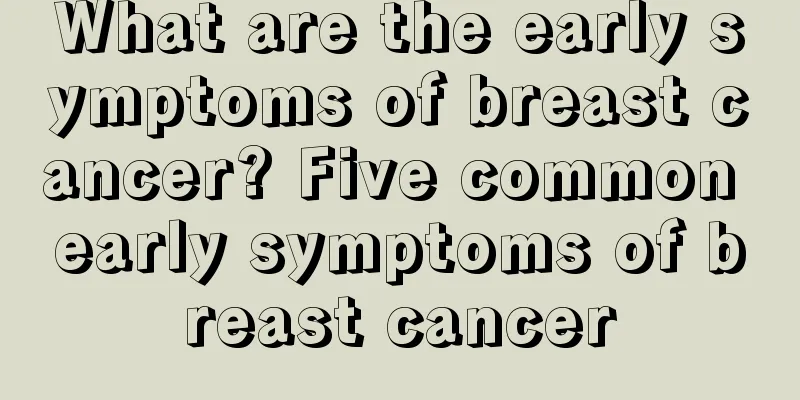What are the early symptoms of breast cancer? Five common early symptoms of breast cancer

|
Breast cancer is a cancer that threatens women's lives. Do you know the early symptoms of breast cancer? How to check? Breast cancer is a malignant tumor that poses a great threat to women's health. The harm is self-evident. In recent years, the incidence of breast cancer has continued to rise, seriously affecting the physical and mental health of many women. Therefore, it is important to understand the early symptoms of breast cancer in a timely manner. Many patients have missed the best treatment opportunity because the early symptoms are not obvious and are not discovered until the late stage, making treatment very difficult. Early symptoms of breast cancer Lump or pain This is the first symptom of 95% of breast cancer patients. It is mostly single, rare and multiple, and the shape is round, oval or irregular. The texture is generally hard and the boundaries are unclear. When breast cancer is combined with cystic hyperplasia, swelling and dull pain may occur. Pain in advanced breast cancer often indicates that the tumor directly invades the nerves. 2. Changes in nipple and areola Breast cancer is in the center of the breast and the large ducts are invaded, which can cause the nipple to flatten, become sunken, shrink, or even fall down, resulting in deformation of the areola. 3. Skin changes Common manifestations include superficial venous distention, dimples, and orange peel skin. Axillary lymphadenopathy The first symptom of breast cancer is rare (unless it is occult breast cancer). Most of them indicate the progression of breast cancer, and pathological examination can help to diagnose. 5. Nipple discharge Breast cancer with discharge accounts for 1.3-7% of all breast cancers, and is more common in intraductal carcinoma and papillary carcinoma. Bloody discharge is the most common, followed by serous, serous blood, and watery discharge. Clinical Detection Methods for Breast Cancer Breast palpation examination Every woman should do a self-examination on the fifth day after the end of menstruation. The method is to apply soap on your hands and use the belly of the middle finger and index finger to search the breasts, armpits and clavicle fossa clockwise. Experts are very experienced and it is more accurate to judge whether there is a lump by touch. If you feel a lump when you touch your breast, it may be breast cancer. Take off your jacket, face the mirror, and check if the nipple is protruding, the skin is wrinkled, sunken, the nipple is contracted, the level of the nipples on both sides is consistent, and the contour has changed. Raise your left arm, put your right index finger, middle finger, and ring finger together, and use the belly of your fingers to gently press the left breast area to see if there are lumps. Be careful not to pinch with your fingers. Check the right breast in the above way. Lie on your back, with your left arm over your head, and a small pillow under your left shoulder. Check again according to steps 2 and 3; if you find lumps, nodules, or other abnormalities, you should go to the cancer hospital in time. Skin changes: Breast cancer invading the skin can cause skin-specific changes, with orange skin being the most vivid; there is also a special type of breast cancer that manifests mainly as inflammatory changes in the breast skin, with skin color ranging from light red to dark red, accompanied by skin edema, thickening, and increased surface temperature, which can extend from local areas to the entire breast. 2.Use B-ultrasound examination When a doctor suspects a breast lump, he must do a B-ultrasound to determine the nature and location of the lump. However, B-ultrasound can only identify lumps with a diameter of less than 1 cm and may miss smaller lumps. 3. Check with mammography target This is the most accurate method for the initial diagnosis of breast cancer. It can obtain clear images and detect the budding of some small tumors, but the cost is higher than B-ultrasound examination. |
<<: Does IVF increase the risk of breast cancer? 6 common misunderstandings about IVF
Recommend
Reasons why venous blood turns black
Veins are very important blood vessels in the hum...
What are the symptoms before death from lung cancer
Lung cancer originates from the bronchial mucosal...
Look at health issues from the tongue
When Chinese medicine practitioners treat patient...
A brief analysis of the dietary therapy for bladder cancer treatment
With the continuous advancement of medical techno...
Summarize the symptoms of testicular cancer
Although the early symptoms of most cancers are n...
Beware of possible early symptoms of colon cancer
Colon cancer refers to malignant lesions of the c...
Brief introduction to osteosarcoma related knowledge
Osteosarcoma is like a tumor. It can seriously ha...
The efficacy and function of Niu Teng
I don’t know if you have seen the Chinese medicin...
My front teeth and gums hurt
Swollen and painful gums are a very common phenom...
What is the treatment for rubella symptoms?
Rubella is a common skin disease, but many people...
My skin is a little red and itchy after washing my face with cucumber
Cucumber is the common cucumber in people's d...
Brain cancer patients will benefit from doing more aerobic exercise
For brain cancer patients, appropriate and effect...
Can lymphoma be cured?
In recent years, we have found that the incidence...
How to wash silk fabrics?
In daily life, clothes made of silk fabrics are a...
There is a blood blister on the anus
The human anus is prone to many situations. If co...









